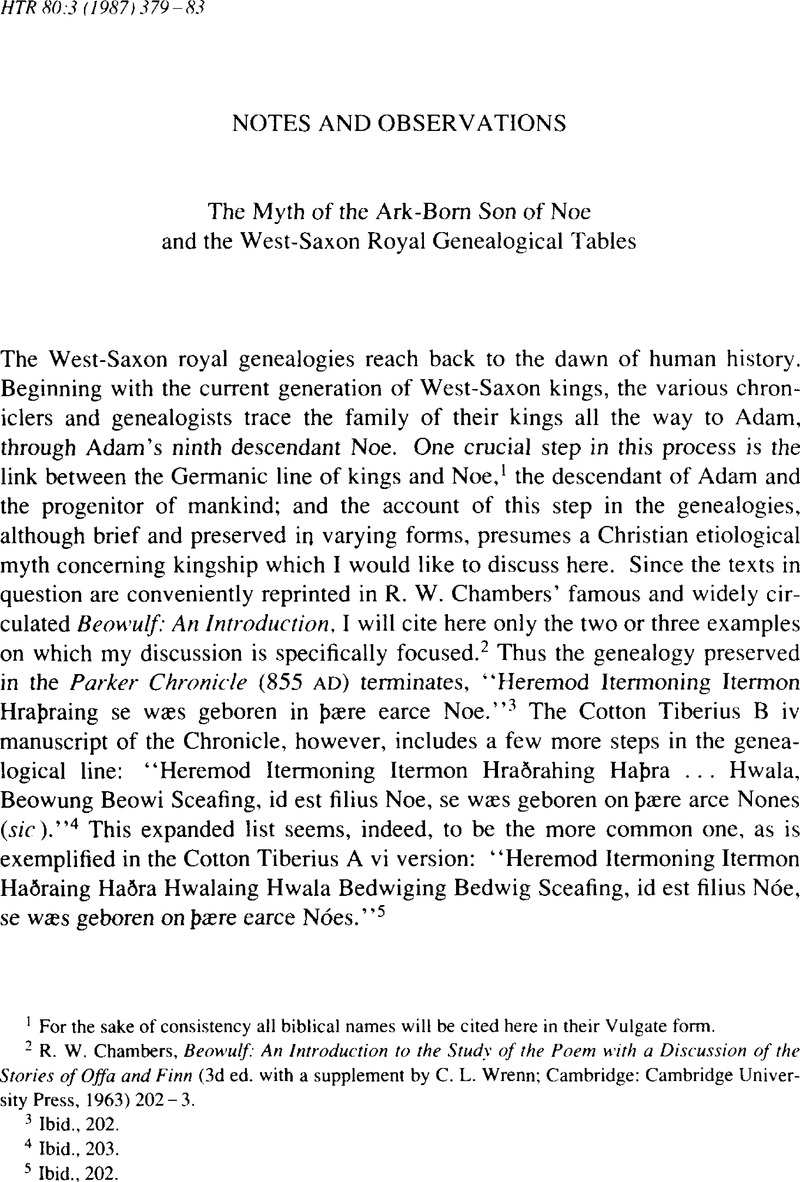Article contents
The Myth of the Ark-Born Son of Noe and the West-Saxon Royal Genealogical Tables
Published online by Cambridge University Press: 10 June 2011
Abstract

- Type
- Notes and Observations
- Information
- Copyright
- Copyright © President and Fellows of Harvard College 1987
References
1 For the sake of consistency all biblical names will be cited here in their Vulgate form.
2 Chambers, R. W., Beowulf: An Introduction to the Study of the Poem with a Discussion of the Stories of Offa and Finn (3d ed. with a supplement by Wrenn, C. L.; Cambridge: Cambridge University Press, 1963) 202–3.Google Scholar
3 Ibid., 202.
4 Ibid., 203.
5 Ibid., 202.
6 See, e.g., Rad, Gerhard von, Genesis: A Commentary (trans. Marks, J. H.; Philadelphia: Westminster, 1972) 139–45.Google Scholar
7 See, e.g., Bede's comment on Gen 10:1: “Filii autem filiorum Noe qui commemorantur creduntur singuli singularum gentium progenitores extitisse, qui inter se orben diuiserunt” (In Genesiam 3:1; CCSL 118A, 142; PL 91, 115).
8 The error might have resulted from a conflation of the biblical “Sem” and the name “Scef” which is found in most of the other lists.
9 Bede's Ecclesiastical History of the English People (ed. Colgrave, Bertram and Mynors, R. A. B.; Oxford: Clarendon, 1969) 50 (i, 15).Google Scholar
10 Gero, Stephen, “The Legend of the Fourth Son of Noah,” HTR 73 (1980) 321–30.CrossRefGoogle Scholar
11 Ps-Methodius is not mentioned in Ogilvy's, J. D. A.Books Known to the English, 597–1066 (Cambridge: Medieval Academy of America, 1967)Google Scholar, but Ps-Methodius is cited by name and Methodian matter quoted in some late Old English and Latin notes in The Old English Hexateuch. The Old English notes are printed in Crawford's, S. J. edition, The Old English Version of the Heptateuch: Aelfric's Treatise on the Old and New Testament and His Preface to Genesis (1922; reprinted London: Oxford University Press, 1969) 418–22.Google Scholar The Old English notes are late (mid-12th century), but Crawford argues that they are copied from an earlier exemplar. The Latin notes are, to the best of my knowledge, unpublished and only available in the facsimile edition of Dodwell, C. R. and Clemoes, Peter, The Old English Illustrated Hexateuch (British Museum Cotton Claudius B iv; Copenhagen: Rosenkilde og Bagger, 1974).Google Scholar
12 Sibyllinische Texte und Forschungen: Pseudomethodius, Adso und die Tiburtinische Sibylle (ed. Sackur, Ernst; Halle: Niemeyer, 1898) 63–64.Google Scholar I have provided a literal and in places rather tentative translation for the convenience of the reader. Nimrod, the prototype of Nebroth in this text, is descended from Ham, not Sem, according to the Vulgate. For a convenient discussion of Ps-Methodius and relevant bibliographical information, see McGinn, Bernard, Visions of the End (New York: Columbia University Press, 1979) 70–73, passim.Google Scholar
13 See Chambers, Beowulf, 80.
14 The insistence of the author of the fragmentary compilation of biblical lore preserved in Cotton Tiberius A iii, fols. 43–44 that no one survived the flood except Noe and his sons and their wives, and that “þær næfre tolafe newearþ ma þonne him eahtum” reflects a possible counter-reaction against the myth of the ark-born son of Noe. The text is edited by Napier, A. S., “Altenglische Kleinigkeiten,” Anglia 11 (1889) 2–5.Google Scholar
- 4
- Cited by




